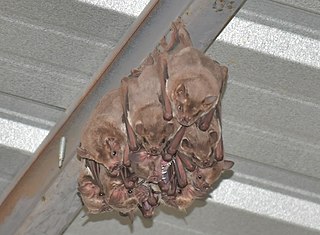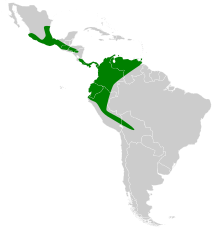
The New World leaf-nosed bats (Phyllostomidae) are found from southern North America to South America, specifically from the Southwest United States to northern Argentina. They are ecologically the most varied and diverse family within the order Chiroptera. Most species are insectivorous, but the phyllostomid bats include within their number true predatory species and frugivores. For example, the spectral bat, the largest bat in the Americas, eats vertebrate prey, including small, dove-sized birds. Members of this family have evolved to use food groups such as fruit, nectar, pollen, insects, frogs, other bats, and small vertebrates, and in the case of the vampire bats, even blood.

The Jamaican, common or Mexican fruit bat is a fruit-eating bat native to Mexico, through Central America to northwestern South America, as well as the Greater and many of the Lesser Antilles. It is also an uncommon resident of the Southern Bahamas. Populations east of the Andes in South America are now usually regarded a separate species, the flat-faced fruit-eating bat. The distinctive features of the Jamaican fruit bat include the absence of an external tail and a minimal, U-shaped interfemoral membrane.

The great fruit-eating bat is a bat species found from Mexico to Brazil and Argentina, as well as in Antigua and Barbuda, Barbados, Grenada, Martinique, Saint Lucia, Saint Vincent and the Grenadines and Trinidad and Tobago.

Andersen's fruit-eating bat is a bat species found in South America.

Dermanura is a genus of leaf-nosed bats.

The Neotropical fruit bats (Artibeus) are a genus of bats within the subfamily Stenodermatinae. The genus consists of 12 species, which are native to Central and South America, as well as parts of the Caribbean.

The fraternal fruit-eating bat is a species of bat in the family Phyllostomidae that is found in drier habitats in Ecuador and Peru. It was formerly considered to be a subspecies of the Jamaican fruit bat, but was raised to species level in 1978. The smallest species in the group of large Artibeus, it has a forearm length of 52–59 mm (2.0–2.3 in), a total length of 64–76 mm (2.5–3.0 in), and a weight of 30–55 g (1.1–1.9 oz).

The Toltec fruit-eating bat is a species of bat in the family Phyllostomidae. It is also sometimes called the "lowland fruit eating bat."

Stenodermatinae is a large subfamily of bats in the family Phyllostomidae.

Thomas's fruit-eating bat, sometimes also popularly called Watson's fruit-eating bat, is a species of bat in the family Phyllostomidae. It is found from southern Mexico, through Central America to Colombia. Its South American range is to the west of the Andes. The species name is in honor of H. J. Watson, a plantation owner in western Panama who used to send specimens to the British Natural History Museum, where Oldfield Thomas would often describe them.
Knud Christian Andersen was a Danish zoologist. His research focused on bats.
Artibeus schwartzi is a species of bat found in the Lesser Antilles. It was previously considered a subspecies of the Jamaican fruit bat,. It has been hypothesized that it arose from hybridization of three Artibeus species: A. jamaicensis, A. planirostris, and an unknown third species.
The Bogota fruit-eating bat is a species of bat found in South America.









